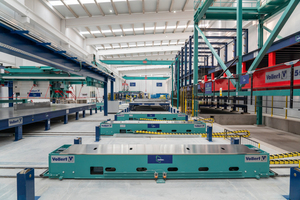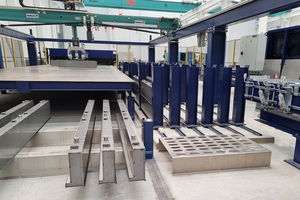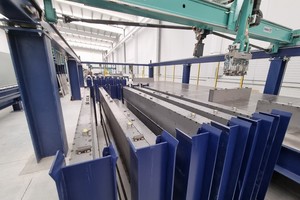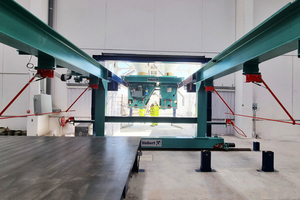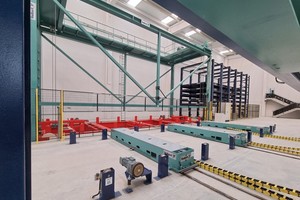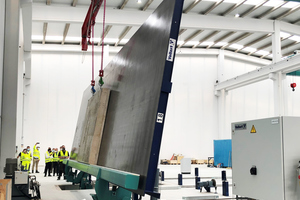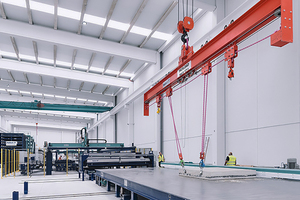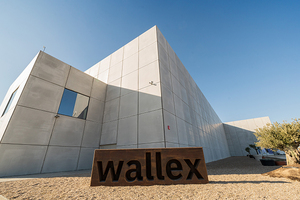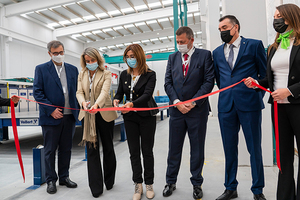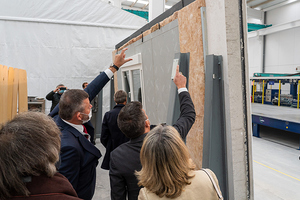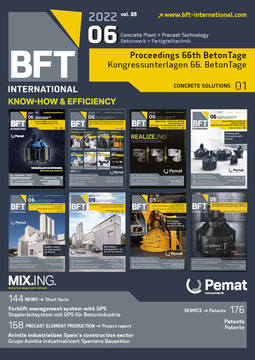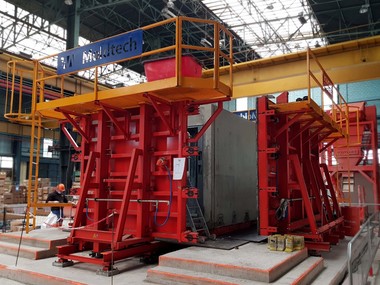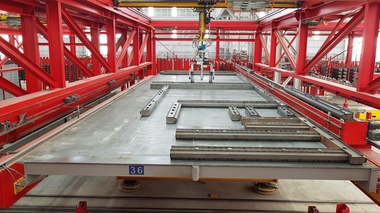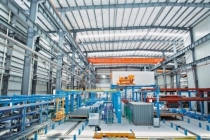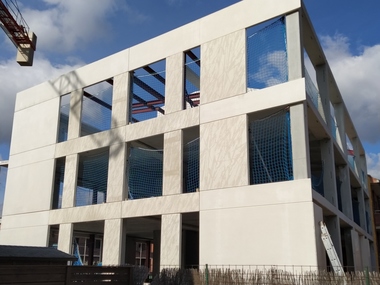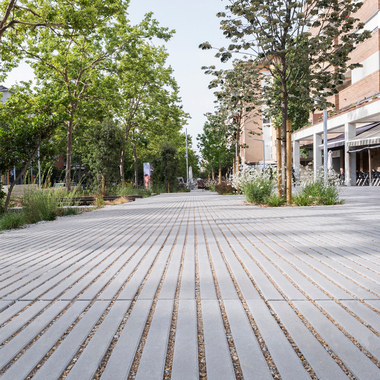Grupo Avintia industrializes at highspeed Spain‘s construction sector
In the Iberian Peninsula, the share of industrial construction is less than 1%, compared to 45% in Central and Northern Europe in 2020. Against this background, Grupo Aviantia, one of Spain‘s leading developers, has developed Ávit-A, an integral, industrialized construction system.
In the Iberian Peninsula, the share of industrial construction is less than 1%, compared to 45% in Central and Northern Europe in 2020. Against this background, Grupo Aviantia, one of Spain‘s leading developers, has developed Ávit-A, an integral, industrialized construction system. Climate neutrality in the building process and sustainability in the housing sector are decisive milestones in 21st century.
Sustainability and climate neutrality are one of the essential challenges of today. Politics and business must face up to this, also and especially for the construction industry. Materials and building systems must continue to develop so as to achieve the climate targets that have been set. This applies to the construction process itself, but factors such as energy consumption, air-conditioning and ventilation technology, and state-of-the-art smart home technology must also be taken into account in the life cycle of residential buildings. At the same time, housing must be created worldwide in the short term and in a manner that is affordable for many people.
„We are talking about a healthy and comfortable living environment, sensorized and networked residential buildings. Industrialized construction with well-organized processes and the highest quality specifications provides the solution. We are already seeing this very well in Scandinavia,“ says José Ignacio Esteban, General Director at Avintia Industrial. „Precast, ready-for-use concrete elements not only reduce construction times by up to 30%, but also optimize the quantities of raw materials used already in the manufacturing process and reduce material scrap by up to 60%. It is manufactured just-in-time for the next construction process, industrially, and not on the construction site. This also reduces noise, dust and dirt ‚on-site‘, i.e. at the construction site. The CO2 footprint will thus be significantly lower than today. Weather influences will also no longer play a role. And the cliché no longer prevails that this method of construction in architecture limits creativity.“ Spain‘s leading developer, Grupo Avantia, has already been working intensively on this topic since 2019. The result is Ávit-A, an integral, highly industrialized construction system, first presented in August 2020. „In the Iberian Peninsula, almost 99% of construction is still conventional. We cannot solve the coming challenges with this. With Ávit-A, we are setting a high growth rate, not only for Gruppo Avintia, but for the entire construction sector in Spain. We are leading the way as a driver of innovation,“ says José Ignacio Esteban. Ávit-A is fully integral, from the architect‘s initial BIM models to the construction site, all construction processes are 100% digital and through-controlled. Ávit-A integrates hardware and software, people and technology. „This is also our way of meeting the increased demand for ‚build to rent‘. The demand for rental housing has been increasing for years, regardless of the crisis, and this is because the housing model that the new generations are looking for is far from the traditional models. Therefore, a very pronounced trend will be renting and, therefore, building to rent, to which Ávit-A will contribute greatly,“ said Esteban.
Wallex established as a joint venture in 2020
„In order to handle more than 75% of the construction processes in an industrialized manner and independent of the construction site, a general change in mindset is required,“ describes Steffen Schmitt, Project Manager Sales at the plant engineering specialist Vollert. „Conventional construction methods, which we have practiced for centuries, cannot solve the challenges described, such as reconciling climate change, modern architecture and necessary living space. The digitalization of the construction process is crucial as well as the highly automated, factory-based pre-production of all components and building elements such as walls and floor slabs. To this end, Grupo Avintia‘s construction designers have developed Ávit-A, a powerful new building system to reorient Spain‘s construction sector.“
For the special architecture in our construction projects, Ávit-A uses sandwich walls with special curtain walls. For the interior walls, we use efficient and slender solid concrete components. „Despite the current still difficult Covid 19 framework conditions in Spain, we initially plan to build 1,000 apartments per year starting in 2022,“ explains José Ignacio Esteban. For the plant technology to produce the precast concrete elements, Grupo Avintia specifically sought the know-how and expertise of an experienced concrete plant specialist. „The selection discussions for this were very intensive. It was important for us to be able to discuss controversial topics in order to optimally integrate the processes on the production side into the Ávit-A concept,“ says Sánchez. The contract was signed in July 2020 after intensive discussions. Francisco Marcos from Wimac acted as Vollert‘s Spanish-speaking contact person throughout the project as Vollert‘s representative for the Iberian Peninsula.
Besides the selection of the plant technology, the optimal location for Grupo Avintia‘s first precast concrete plant was searched for in parallel. „With Aranda de Duero in the south of the province of Burgos, we have chosen a strategically important region. In the future, we will supply our residential construction projects in the greater Madrid area centrally and just-in-time from here,“ explains Raquel Calderón Miguel as the responsible Head of Operations at Avintia.The basis is a joint venture between Grupo Avintia and Cemex, one of the world‘s leading concrete specialists. „With Cemex Ventures, we have a long-term partner at our side. Especially against the background of the CO2 footprint, the right concrete mix plays a dominant role. Under the joint brand Wallex, we have created a leading new market player in Spain.“
State-of-the-art machine technology and self-compacting concrete
Today‘s precast concrete production relies on a very high level of automation, state-of-the-art machine technology and robotics, intelligent CAD/CAM-controlled processes, and the integration of BIM/ERP and production control systems. The automotive industry was the absolute benchmark here for many decades and has certainly also played a pioneering role for the construction sector. „From the very beginning of the planning process, we have intensively studied the construction system and the planned construction projects of Grupo Avintia. In order to serially manufacture large-sized sandwich and solid wall components on the same transport line, an intelligent concept is required in industrial prefabrication that takes into account the issues already mentioned,“ explains Jürgen Hesselbarth, the responsible project manager at Vollert.
Right from the start, the company planned with an extremely compact plant layout. On the one hand, because building land in the region is expensive, and on the other hand, the company opted for an optimally dimensioned system hall. „Even though the issue of renting an existing building versus building a new one on a greenfield site was initially analyzed,“ reports Jürgen Hesselbarth. 19 transport pallets move between the individual workstations on a circulation basis. „Robotics combined with the latest laser technology, permanent quality checks and a zero-defect strategy is a good way to summarize the concept,“ describes Raquel Calderón Miguel from Avintia. The transverse and longitudinal shuttering profiles, which are up to 310 mm high, are positioned on the Smart Set robot line under CAD/CAM control without gaps using the so-called windmill principle, i.e. circular. The same applies to the magnetic boxes for the door and window recesses of the solid walls and the load-bearing layers of the sandwich walls. The shuttering system was specially adapted to the Àvit-A construction system in close dialog. Besides the shuttering process, the Smart Set preplots contours for built-in parts and other supplementary components.
Another essential factor for the subsequent wall quality is the concreting process. A fully automatic Smart Cast semi-portal concrete spreader ensures optimum concrete cycle times and precise concrete dosing. Under- or over-concreting of the desired discharge quantity is reduced here, and this with process reliability and very high availability. „A special feature here is that we use a special self-compacting lightweight concrete developed by Cemex. This is metal fiber reinforced, which makes the use of traditional reinforcement mesh and lattice girders superfluous,“ explains Jürgen Hesselbarth. „Due to the consistency, we are working here with a sliding device. In addition, a twin concrete bucket is used, i.e. a 3.3 m3 bucket that applies the concrete for the solid inner walls and the load-bearing layer of the sandwich wall, and a 1.6 m3 bucket that lays the concrete for the facing layer. „ In sandwich wall production, after the concrete of the facing layer has been applied, the insulation preparation and the insertion of other built-in parts such as connecting and lifting anchors, which are predesigned by means of a laser projection system, take place first. Afterwards, the upper or load-bearing layer of the sandwich wall is concreted. To receive the concrete, the concrete spreader has a transverse exit. Subsequent compaction of the concrete does not apply due to the self-compacting characteristic of the material. The curing process is ensured by a Vario Cure curing chamber with two rack towers and 10 curing places each. A stationary Vario Store storage and retrieval system feeds in and out the pre-concreted wall elements.
After the complete curing process, the prefabricated walls, after being manually stripped of their formwork, move on to final assembly. For this purpose, a laser is first used to project which interior insulation and substructures are to be preassembled for the construction site. All components are then delivered to the construction site completely ready for use with pre-filled sheetrock. For loading onto transport racks, the walls are erected by means of a Vario Tilt tilting station. Instead of the standard 80°, this is also done at 85° and 90° so that the sandwich walls can be safely removed without edge breaks. Synchronization is achieved by laser path measurement and proportional valves. A lifting beam is used to remove the walls from the tipping station and place them on loading racks. This is followed by the installation of the windows and doors as well as the electrics in a further work area.
3D BIM and ERP system intelligently integrated
The production control system used is also crucial for maximum plant productivity. The Vollert Control Center (VCC) is the central interface for the constructively created data from the 3D BIM system from Trimble/Tekla, the ERP system from RIB SAA and the machine technology. Throughput times and automated pallet occupancies are permanently optimized, all machines are controlled, data is automatically tracked and processed, retrieval sequences and curing times are managed, and a large number of statistics are made available. „It is therefore often referred to as the brain of the modern precast concrete plant“ says Steffen Schmitt from Vollert. „Both factors, the machine technology and an intelligent plant control system, were for us the keystones for the optimal start-up of precast concrete production at Wallex.“
The challenges of the new way of building
Despite the sometimes very difficult conditions caused by the Covid 19 pandemic, all the assembly work was completed on schedule. „In August 2021, we were able to produce the first solid and sandwich walls in Aranda de Duero,“ explains José Antonio Fuertes, Operations Manager at Wallex. „We will soon be supplying the first construction projects from Aranda de Duero. At a fast pace, the next months and years will fundamentally revolutionize the construction sector. Even if we currently see more challenges. „On the one hand, new apprenticeship occupations are needed for industrialized construction. Among other things, we need well-trained architects, construction planners, project managers, but also skilled workers. On the level of legislation, there is currently no legal framework for this type of construction and also no funding opportunities. But alongside that, challenges on a social and political level to break stereotypes that prefabricated housing has brought for decades.“
The industrialization of the construction sector, which currently accounts for 7% of Spain‘s gross domestic product, will lead to an overall construction boom and a growing economy. Grupo Avintia is convinced of this. At the same time, new jobs will be created. „The construction costs will not be higher, but rather lower in the long term than with conventional construction methods,“ says Marie Luisa Prieto Sánchez. Against this background, Grupo Avintia is sticking to its ambitious growth targets.
CONTACT
Vollert Anlagenbau GmbH
Stadtseestr. 12
74189 Weinsberg/Germany
+49 7134 52-0

